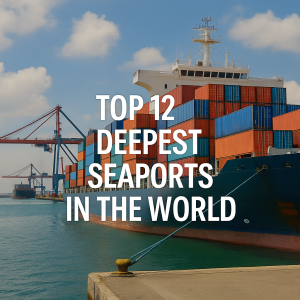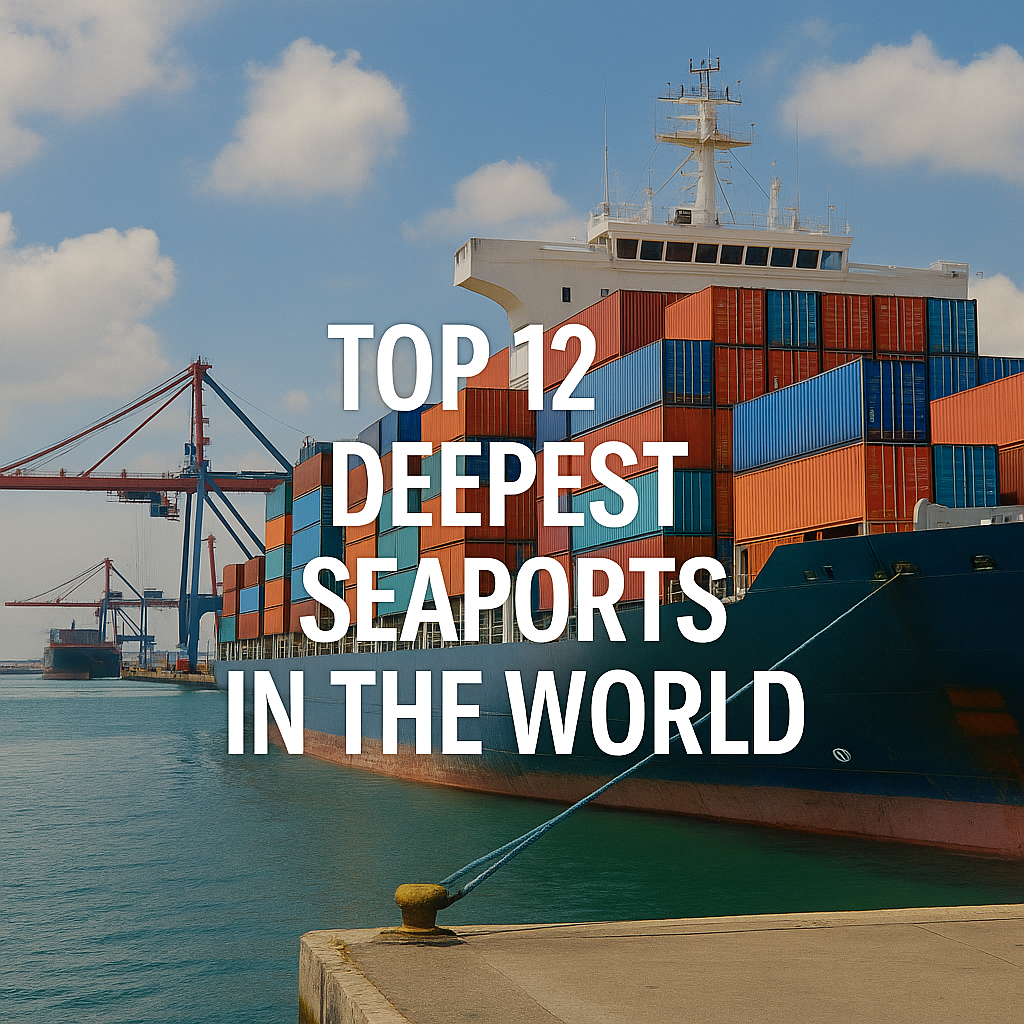Explore the top 12 deepest seaports in the world. Discover how their immense depths support megaships, global trade, and maritime innovation in this expert guide.
Why Deep Seaports Matter in Modern Maritime Operations
In the high-stakes world of maritime logistics, depth is destiny. As container ships grow ever larger—like the Ever Ace, capable of carrying over 24,000 TEUs—only the deepest seaports can accommodate these ocean giants. Deepwater ports are critical enablers of global commerce, handling bulk carriers, liquefied natural gas (LNG) tankers, ultra-large container vessels (ULCVs), and naval fleets.
According to the International Maritime Organization (IMO) and UNCTAD, over 80% of global trade by volume travels via sea. The ability of ports to handle such immense loads hinges not only on berth capacity or intermodal infrastructure, but also on navigational depth, typically measured in meters below chart datum (CD).
In this article, we highlight the 12 deepest commercial seaports globally—those that blend natural geographic advantage with engineering brilliance.

What Defines a “Deep” Seaport?
A deep seaport typically refers to a port with natural or dredged depths of 16 meters (52.5 feet) or more. The IMO and port authorities worldwide monitor depth to ensure vessel safety, especially in relation to tidal windows, squat effects, and under-keel clearance. Depth becomes even more vital in ports serving vessels classified under Panamax, Post-Panamax, and ULCV specifications.
–
Top 12 Deepest Seaports in the World
1. Port of Rotterdam, Netherlands – Depth: 24 meters
Europe’s largest seaport, Rotterdam’s Maasvlakte 2 extension includes berths dredged to 24 meters, making it one of the deepest container ports on Earth. The Automated Delta Terminal and LNG bunkering capabilities place it at the technological forefront.
Authority: Port of Rotterdam Authority
Website: portofrotterdam.com
2. Port of Shanghai, China – Depth: 23 meters
Shanghai is the world’s busiest port by cargo tonnage and container throughput. The Yangshan Deep-Water Port is constructed on an archipelago and connected via the 32-kilometer Donghai Bridge.
Highlight: Handles 47+ million TEUs annually.
Website: portshanghai.com.cn
3. Port of Singapore – Depth: 21 meters
Strategically positioned at the confluence of East-West shipping routes, Singapore’s Tuas Mega Port features berths up to 21 meters deep, equipped for AI-automated cranes and Inmarsat digital connectivity.
Sustainability Note: Part of Singapore’s Green Port Programme.
Website: mpa.gov.sg
4. Jebel Ali Port, UAE – Depth: 17 meters
Operated by DP World, Jebel Ali is the largest man-made harbor in the world. Its terminals support Post-Panamax vessels and facilitate Middle East-Europe-Asia connectivity.
Strategic Role: U.S. Navy logistics hub in the Gulf.
Website: dpworld.com
5. Port of Los Angeles, USA – Depth: 16.2 meters
The largest container port in North America, LA’s depth allows it to berth vessels such as CMA CGM Benjamin Franklin. Sustainability programs include cold ironing and zero-emission cargo handling.
Green Leadership: Collaborates with California Air Resources Board (CARB) and IMO on port electrification.
Website: portoflosangeles.org
6. Port of Yokohama, Japan – Depth: 17 meters
With earthquake-resilient infrastructure, Yokohama accommodates mega-containerships and oil tankers. It plays a central role in Japan’s supply chain resilience and export economy.
Notable Feature: Daikoku Pier with modern LNG terminals.
Website: city.yokohama.lg.jp
7. Port of Durban, South Africa – Depth: 19 meters
The deepest and busiest port in sub-Saharan Africa, Durban is vital for bulk cargo, containers, and energy imports. A $1 billion expansion plan includes deeper berths and smart traffic systems.
Global Trade Role: Key for BRICS shipping and African logistics corridors.
Website: transnet.net
8. Port of Colombo, Sri Lanka – Depth: 18 meters
Colombo has become South Asia’s transshipment hub. The Colombo International Container Terminal (CICT), developed in partnership with China Merchants Port, features berths up to 18 meters.
Strategic Initiative: Linked to China’s Belt and Road maritime strategy.
Website: slpa.lk
9. Port of Sydney (Botany Bay), Australia – Depth: 19 meters
Port Botany is Australia’s second busiest container port, supporting energy imports and containerized trade across Asia-Pacific.
Environmental Note: Integrated with Australia’s National Clean Ports Strategy.
Website: portauthoritynsw.com.au
10. Port of Antwerp-Bruges, Belgium – Depth: 17.8 meters
Following its recent merger, Antwerp-Bruges is now the second busiest European seaport. It features LNG-ready terminals, hydrogen pilot projects, and direct access to the Rhine corridor.
Green Maritime Hub: Supports circular economy initiatives.
Website: portofantwerpbruges.com
11. Port of Busan, South Korea – Depth: 17 meters
Busan serves as Korea’s main maritime gateway, and its New Port expansion includes ultra-deep berths and smart cranes using 5G infrastructure.
Academic Link: Collaborates with Korea Maritime and Ocean University.
Website: busanpa.com
12. Port of Manzanillo, Mexico – Depth: 16.5 meters
Manzanillo is Latin America’s most important Pacific port, linking Mexico with Asia and the U.S. West Coast. Recent dredging efforts expanded access to next-gen boxships.
Growth Note: 25% cargo throughput growth post-2020.
Website: puertomanzanillo.com.mx
–
Real-World Application: Deep Ports & Mega Containerships
The 2021 Ever Given Suez Canal crisis illustrated the importance of depth in both canals and seaports. With growing reliance on 400-meter vessels like the Ever Ace, ports with insufficient depth risk exclusion from global shipping loops. DNV reports highlight that by 2030, over 50% of cargo will rely on ULCVs—requiring minimum depths of 17 meters or more.
FAQ Section
1. What makes a port deep?
Ports with a draft of 16+ meters are considered deep. Depth ensures large ships avoid grounding and maintain under-keel clearance.
2. Why is depth important for modern ports?
Deeper ports can handle larger ships, which means more cargo per vessel, improving efficiency and reducing emissions per TEU.
3. Can ports increase their depth artificially?
Yes. Dredging is a common method, although it’s costly and environmentally sensitive.
4. Do deeper ports attract more traffic?
Yes. Deep ports are preferred for transshipment hubs and major container terminals due to better vessel compatibility.
5. How are ports adapting to depth-related challenges?
Through AI route optimization, automated docking systems, and deepening projects supported by BIMCO and national port authorities.
6. What’s the role of class societies in deep port development?
Entities like Lloyd’s Register and ABS provide underwater structural integrity assessments and dredging compliance standards.
Conclusion
The world’s deepest seaports are gateways not only to oceanic depths but also to economic scale, efficiency, and maritime innovation. As shipping lines expand vessel sizes and environmental regulations tighten, only the deepest and most adaptable ports will thrive. They’re no longer just harbors—they’re ecosystems of logistics, automation, and green engineering.
Call to Action:
Maritime professionals, students, and port planners: monitor these seaports for case studies in sustainable expansion and logistics integration. Their evolution offers a model for ports of the future.
References
-
IMO – https://www.imo.org
-
UNCTAD – https://unctad.org
-
DNV Maritime Reports – https://www.dnv.com/maritime
-
Lloyd’s List Intelligence – https://lloydslist.maritimeintelligence.informa.com
-
Port of Rotterdam – https://www.portofrotterdam.com
-
Singapore MPA – https://www.mpa.gov.sg
-
Port of Shanghai – http://www.portshanghai.com.cn
-
DP World Jebel Ali – https://www.dpworld.com/jebel-ali


maritimeducation.com
maritimeducation.com
Top 12 Deepest Seaports in the World: Engineering Depth for Global Trade – Maritime Education
Top 12 Deepest Seaports in the World: Engineering Depth for Global Trade – Maritime Education
Top 12 Deepest Seaports in the World: Engineering Depth for Global Trade – Maritime Education
Top 12 Deepest Seaports in the World: Engineering Depth for Global Trade – Maritime Education
Top 12 Deepest Seaports in the World: Engineering Depth for Global Trade – Maritime Education
Top 12 Deepest Seaports in the World: Engineering Depth for Global Trade – Maritime Education
Top 12 Deepest Seaports in the World: Engineering Depth for Global Trade – Maritime Education
Top 12 Deepest Seaports in the World: Engineering Depth for Global Trade – Maritime Education
maritimeducation.com
maritimeducation.com
Liza Dion
Dear maritimeducation.com admin, Keep the good content coming!
Hello maritimeducation.com webmaster, Your posts are always well-referenced and credible.
Hi maritimeducation.com admin, You always provide key takeaways and summaries.
To the maritimeducation.com webmaster, Great job!